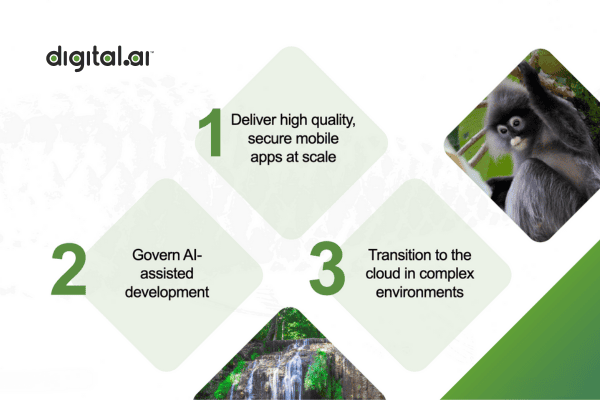The events of the last 12 months have demonstrated that the only sure prediction is that we don’t know what tomorrow will bring. The levels of uncertainty that have resulted from the COVID pandemic struck the heart of business organizations, affecting teams in virtually all departments.
Substantial fears about the risks and insecurity of what lies ahead continue. Meanwhile, in many cases, traditional planning processes were completely disrupted in the months following the initial pandemic lockdowns, and many organizations have not yet recovered. While it’s true that no industry was spared, the hardest-hit industries, namely hospitality, entertainment/media, and travel, were all but frozen in place for months.
While the pandemic did bring unpredictability to a head, the pace of change has been quickening for decades. Legacy business processes need to catch up, and disruptions caused by COVID-19 should be a wake-up call for organizations that are lagging.
Over recent months, digital transformation experts have observed that organizations that were able to quickly evolve fared better than those that found it difficult to pivot. “The ability to adapt and act fast is essential to creating success in this new paradigm and will enable companies to build resilience in the years ahead,” as PwC’s Ben Cotter noted in an article on business reinvention due to COVID.
One fundamental change that organizations can make is to eliminate the process of protracted budget and planning cycles. Projects that take a year or longer to complete, even under ideal conditions, simply cannot weather the events brought on by global instability.
Instead, businesses can move forward by embracing the agile planning approach. This iterative process focuses on the short-term, and for years it has been employed by software teams and, increasingly, other business departments.
A unified agile approach brings amplified benefits
It’s imperative for organizations to apply agile consistently across the entire organization, as a disjointed approach will create additional difficulties. When agile is implemented in an inconsistent manner, the result will be flaws that go beyond merely having pockets of accelerated performance.
For instance, even if agile methodologies are adopted among DevOps teams when other teams and departments are using non-agile methodologies, bottlenecks will develop as work is handed off. These abrupt transitions in other departments will create what are essentially traffic jams, and the resulting gridlock will ripple back to paralyze DevOps teams’ performance.
Furthermore, failing to practice agile methodologies in other departments will lead to additional incongruities that will make genuine agile difficult to practice in the organization. These inconsistencies can create obstacles in various departments.
Let’s consider accounting as an example: locking budgets into a “project” mindset can lead to legacy waterfall practices. For instance, there may be a protracted requirement gathering phase, with the expectation of one big release at the end of each development cycle. Instead of using a locked-in budget approach, products must be continually funded as long as they are active. Then, budget controls can be derived from tracking incremental expenses and value creation at each stage of work.
“The project cost accounting model must change, but the solution has to be mutual, and the results must serve the interests of everyone who reads those accounting reports,” suggests Steven A. Lowe, Product Technology Manager at Google, in an article discussing the concept of lean accounting. He adds, “the first step is to shift the focus from tracking costs by department to modeling costs per value stream.”
Meanwhile, HR departments can take a similar approach to the process of talent review practices. A Harvard Business Review article on innovative talent management reveals that “many organizations have switched to frequent performance assessments, often conducted project by project. This change has spread to a number of industries, including retail (Gap), big pharma (Pfizer), insurance (Cigna), investing (OppenheimerFunds), consumer products (P&G), and accounting (all Big Four firms).”
When all departments use agile methodologies, they can sync not only their goals but their focal areas. When agile is applied to the practice of performance reviews, assessments become more about enabling better work and asking how to improve daily processes. This stands in contrast to the typical annual employee review procedure, which usually just determines whether minimum standards were met.
Similarly, in the area of accounting, agile metrics allow budgeting and finance to reflect current priorities, eliminating the inaccurate view of “cost” centers vs “profit” centers.
While organization-wide agile isn’t necessarily a mandate, the more evenly its methodologies are applied and understood, the more consistent performance and feedback practices will be across the organization.
Extending the benefits of agile planning from software to everything else
With agile planning, short-term goals are set with long-term, value-based targets, and outcomes in mind. This approach encourages work to be done in iterative cycles, often known as “sprints.” At the end of each cycle, there is the opportunity to review performance, learn from it, and then implement that knowledge into the next sprint.
An iterative approach to work that needs to be completed has several main benefits:
- The scope of a new project or product change can be revised as requirements become more apparent.
- New ideas and refinements can be introduced without a significant disruption in the work being performed.
- Project goals can be revised in light of a changing business environment, up to the point of a global disruptive event, such as the COVID pandemic.
Within some organizations, there’s a tendency to think that the benefits of the agile iterative method apply only to software delivery and that attempting to apply this same approach to other departments or functional areas carries too much risk. In reality, betting too heavily on one intended outcome is what is too risky. Being slow to adapt is especially cumbersome when change becomes necessary, as was the case once business shutdowns occurred in the beginning of Q2 of 2020.
When change is needed, latency in action can cause damage that can affect an entire organization. The need to take sudden, dramatic action invites more risk compared to using an iterative approach on various levels or areas. Taking another example from within accounting: if a budget is locked in, there can be huge consequences to making any necessary changes.
In fact, agile methodology can and should apply to the very top-level of work being performed in an organization. Harvard Business Review suggests in an article about agile organizations that, while agile planning may not work for some C-suite activities, many crucial activities should use it, “including, strategy development and resource allocation, cultivating breakthrough innovations, and improving organizational collaboration. Senior executives who come together as an agile team and learn to apply the discipline to these activities achieve far-reaching benefits.”
It’s also important to note that adopting agile is smoother and more successful when there is a buy-in from leadership starting from the top, allowing the agile mindset to permeate the entire organization.
Make agile more pervasive to make businesses less brittle
Although most businesses appreciate the use of agile, it’s often confined to specific applications. In our recent State of Agile Survey, 95% of respondents say that at least some teams are using agile in their organizations. But the survey shows that while 33% say that more than half of their teams use agile, only 14% of respondents report that all teams do.
These results indicate that agile usage needs to increase and that higher-level teams need to embrace agile at a greater rate. Making the successful transition to agile will reduce the vestiges of legacy business practices. In many cases, these legacy practices are what continue to weigh down teams and prevent many businesses from readily adapting to remain competitive — or even viable.
The emphatic response to COVID demonstrates that businesses across many industries are willing to break their own agile-averse rules when times are desperate enough and the need for immediate action is evident. But that need for action never disappears and taking an agile planning approach is the only way to empower innovative actions at any stage of work. Your business plans can’t be derailed if you uncouple planning from rigid rails in the first place. An agile approach allows for fluid and more flexible solutions that will ultimately deliver more value to the customer.
Digital.ai is kicking off a new agile community, Agile.ai, where members will share agile best practices and engage with experienced agile coaches. You can sign up now to indicate your interest and be one of the first to join this community. Additionally, Digital.ai has flexible general agile and Scaled Agile Framework (SAFe) training solutions that help you learn more about agile and how you can use it across your business.
Are you ready to scale your enterprise?
Explore
What's New In The World of Digital.ai
Agile Testing Methodologies and Processes
Stay ahead in the world of software development with our comprehensive guide on agile testing. Discover effective processes, best practices & tools for success.
Explore with Erawan – Introducing Digital.ai’s latest AI-Powered DevSecOps Platform: Erawan Release!
Discover the latest features and capabilities in Digital.ai’s latest AI-powered DevSecOps Platform: Erawan Release!
Comprehensive Guide to Mastering Agile Workflows
Discover the importance of agile workflow management for project success. Learn how Digital.ai’s AI-powered solutions streamline processes & drive innovation.



